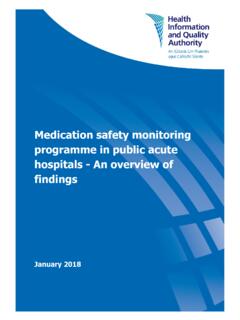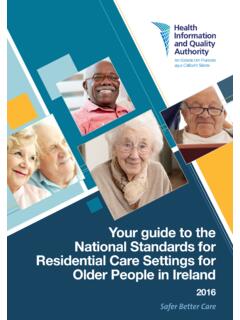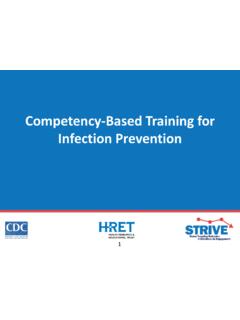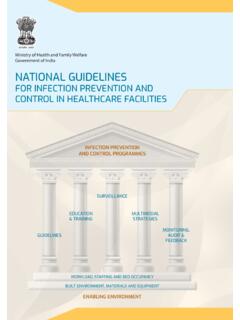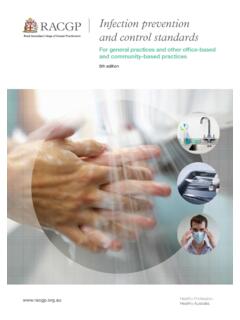Transcription of National Standards for IPC in the Community - HIQA
1 National Standards for infection prevention and control in Community services 2018 National Standards for infection prevention and control in Community services Health Information and Quality Authority Page 3 of 110 About the Health Information and Quality Authority The Health Information and Quality Authority (HIQA) is an independent authority established to drive high-quality and safe care for people using our health and social care services in Ireland. HIQA s role is to develop Standards , inspect and review health and social care services and support informed decisions on how services are delivered. HIQA aims to safeguard people and improve the safety and quality of health and social care services across its full range of functions.
2 HIQA s mandate to date extends across a specified range of public, private and voluntary sector services. Reporting to the Minister for Health and engaging with the Minister for Children and Youth Affairs, HIQA has statutory responsibility for: Setting Standards for Health and Social Services Developing person-centred Standards , based on evidence and best international practice, for health and social care services in Ireland. Regulation Registering and inspecting designated centres. Monitoring Children s Services Monitoring and inspecting children s social services. Monitoring Healthcare Safety and Quality Monitoring the safety and quality of health services and investigating as necessary serious concerns about the health and welfare of people who use these services.
3 Health Technology Assessment Providing advice that enables the best outcome for people who use our health service and the best use of resources by evaluating the clinical effectiveness and cost effectiveness of drugs, equipment, diagnostic techniques and health promotion and protection activities. Health Information Advising on the efficient and secure collection and sharing of health information, setting Standards , evaluating information resources and publishing information about the delivery and performance of Ireland s health and social care services. National Standards for infection prevention and control in Community services Health Information and Quality Authority Page 4 of 110 Note on terms and abbreviations used in these Standards A full range of terms and abbreviations used in these Standards is contained in a glossary at the end of this report.
4 National Standards for infection prevention and control in Community services Health Information and Quality Authority Page 5 of 110 Table of contents About the Health Information and Quality Authority .. 3 Introduction .. 6 1. Background .. 6 2. Purpose of the National Standards .. 8 3. Interaction with other National Standards .. 10 4. Interaction with requirements of other regulatory bodies .. 10 5. Scope of the National Standards .. 11 6. A National approach to infection prevention and control and antimicrobial stewardship 12 7. Themes in the National Standards .. 13 8. Structure of the National Standards .. 15 9. How the National Standards were developed .. 16 Key terms used in the National Standards .
5 18 Summary of the National Standards for infection prevention and control in Community services .. 20 Theme 1. Person-centred Care and Support .. 23 Theme 2. Effective Care and Support .. 28 Theme 3. Safe Care and Support .. 41 Theme 4. Better Health and Wellbeing .. 51 Theme 5. Leadership, Governance and Management .. 55 Theme 6. Workforce .. 65 Theme 7. Use of Resources .. 70 Theme 8. Use of Information .. 74 Glossary of terms and abbreviations .. 80 Bibliography .. 94 Appendix 1 Membership of the Advisory Group and the HIQA Project Team .. 107 National Standards for infection prevention and control in Community services Health Information and Quality Authority Page 6 of 110 Introduction 1.
6 Background The Health Information and Quality Authority (HIQA) is the statutory body established under the Health Act 2007 to drive high-quality and safe care for people using health and social care services in Ireland. One of HIQA s many functions is to set Standards for health and social care services. Preventing and controlling healthcare-associated infections continues to be a significant challenge to healthcare systems throughout the world, including Ireland. These are infections that develop either as a direct result of healthcare interventions, such as medical or surgical treatment, or from being in contact with a healthcare setting. A number of these infections are no longer confined to the hospital setting and are increasingly prevalent in health and social care services in the Community .
7 Healthcare-associated infections can have a huge impact on people, causing anxiety and upset, serious illness, long-term disability and death. Healthcare-associated infections can also have significant resource impacts on Community services due to additional consultations, diagnostic tests and additional care needs. As a result of the rapid turnover of patients in acute healthcare settings, complex care is increasingly being delivered in the Community . Many residents in long-term residential care facilities such as nursing homes are particularly vulnerable to healthcare-associated infections due to a number of risk factors including older age, an increased risk of pressure ulcers and the presence of medical devices such as urinary catheters and feeding tubes.
8 A National survey of healthcare-associated infections and antimicrobial medication use in long-term care facilities in 2016 found that at any point in time about 1 in 25 residents have a healthcare-associated infection.* However, a significant proportion of healthcare-associated infection is known to be avoidable if measures are taken to identify and address the work practices, equipment and environmental risks that have the potential to cause infection. These measures are collectively referred to as infection prevention and control and describe the practice of providing safe care in a clean environment. The basic principles of infection prevention and control apply regardless of the setting.
9 Preventing infections from occurring in the first instance is one of the best ways to * HSE Heath Protection Surveillance Centre. Point Prevalence Survey of Healthcare-Associated infections and Antimicrobial Use in Long-Term Care Facilities. 2016 National Standards for infection prevention and control in Community services Health Information and Quality Authority Page 7 of 110 reduce the need to prescribe antimicrobial medication and help prevent antimicrobial resistance, an issue which represents a serious global threat to health. Antimicrobial resistance occurs when a micro-organism develops resistance to an antimicrobial medication that had been originally effective for treating infections caused by it.
10 The extensive use, misuse and overuse of antimicrobial medications have contributed to increased antimicrobial resistance. The total volume of antibiotics consumed annually in the Community has increased over the last ten years, although a small decrease was seen in 2017 compared with 2016. There is also considerable variation in antibiotic consumption in Community settings by county across Ireland. Antimicrobial stewardship is about ensuring that every person receives the right antimicrobial medication at the right dose, route and duration, and for the right infection type at the right time. These principles of good antimicrobial stewardship apply to all those who prescribe, dispense, administer, use and dispose of antimicrobials.


